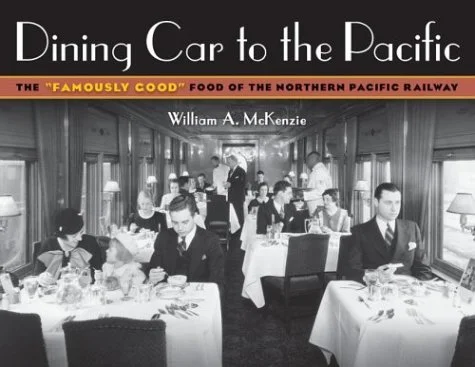The late William A.McKenzie, corporate historian for the Northern Pacific Railway for the better part of three decades, researched and compiled this careful record of the railroad's dining car service, once considered the epitome of hospitality in passenger rail.
McKenzie's text and accompanying historic photos illustrate how the Northern Pacific Railway's dining car service developed, how food was procured and prepared, who the people were who prepared and served the meals, and how the service was used to promote the railroad. One of its 10 chapters -- about a fourth of its pages -- is devoted to recipes for 150 drinks and dishes served on the line, from rice and ham griddle cakes to banana cream pie.
The origins of the luxury dining car are traced back to George Pullman's Pullman Palace Car Company, which introduced the first "hotel car" in 1867 -- providing "comfortable seats by day that could be converted to beds by nights; it included a miniature kitchen, where a chef could conjure up meals fit for the world's nobility" -- and then the true dining car, Delmonico, "progenitor of a line that survived with little change until the mid-1970s. when Amtrak introduced a bilevel diner," McKenzie writes.
Dining cars on Northern Pacific line, covering over 2,766 miles from St. Paul to Chicago and then west to Seattle, became famous not only for the quality of their food and service, but also the regional fare drawn from the territories it crossed: beef, bison and trout from Montana; breads made from the flours of North Dakota wheats; beers crafted from Dakota hops; crab and reindeer native to Alaska; Pacific Coast clams and salmon; and "Great Big Baked Potatoes" from the Yakima Valley of Washington.
Originally published as Dining Car Line to the Pacific by the Minnesota Historical Society Press in 1990, this new edition in a handsome trade paperback rekindles fond memories and wets the appetite for nostalgic rail dining.
